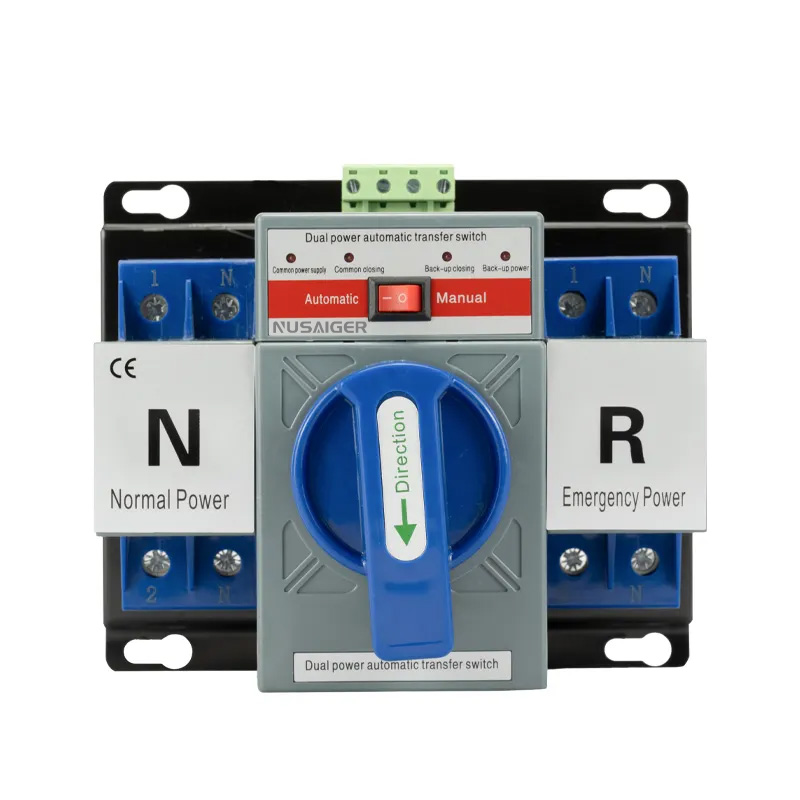How to Choose the Right Dual Power Supply System: Selection Guide and Best Practices
Choosing the right dual power supply system is critical for ensuring uninterrupted power in hospitals, data centers, factories, and commercial buildings. A carefully selected system not only provides reliability but also minimizes downtime, reduces maintenance costs, and ensures compliance with industry standards. This article provides a comprehensive guide to selecting the ideal dual power system for your facility.
1. Introduction: The Importance of Proper Selection
Power outages can be costly. According to industry reports, unplanned downtime in data centers can cost up to $5,600 per minute, while hospitals risk patient safety. Choosing an appropriate dual power supply system ensures continuous operations and prevents financial and operational losses.
2. Assessing Your Facility’s Power Requirements
Start by understanding your facility’s electrical needs:
- Critical Loads: Identify equipment that cannot tolerate downtime, such as servers, medical devices, or industrial machinery.
- Non-Critical Loads: Lights, HVAC, or general appliances can tolerate temporary outages.
- Total Load Calculation: Sum all loads in kVA or kW, including a safety margin (typically 20-30%).
- Future Expansion: Consider potential load increases to avoid under-sizing.
3. Understanding Available Power Sources
Dual power supply systems can draw power from multiple sources:
- Utility Grid: Primary source, reliable but subject to occasional outages.
- Diesel or Gas Generators: Backup power for extended outages.
- UPS (Uninterruptible Power Supply): Provides instant, short-term power during transfers.
- Renewable Sources: Solar or wind can be integrated for hybrid systems.
4. Choosing the Right Automatic Transfer Switch (ATS)
The ATS is the central component that ensures seamless switching:
- Open vs Closed Transition: Open transition is simpler and cost-effective; closed transition ensures uninterrupted power for sensitive equipment.
- Static vs Electromechanical: Static switches provide near-instant transfer, ideal for data centers and hospitals.
- Load Capacity: Ensure ATS can handle the peak load of your system.
- Communication: Smart ATS with remote monitoring can improve reliability and reduce maintenance costs.
5. Evaluating Reliability and Redundancy
Redundancy ensures that a single failure does not disrupt operations:
- N+1 Redundancy: One extra unit ensures continuous operation if one source fails.
- Dual Feed from Different Grids: Protects against grid-level failures.
- UPS Integration: Provides short-term backup during generator startup.
6. Industry Standards and Compliance
Select systems that meet international standards to ensure safety and reliability:
- IEC 60947-6-1: Standards for ATS devices.
- UL 1008: North American standard for transfer switches.
- GB/T 14048.11: Chinese standard for low-voltage switchgear.
- NFPA 70 (NEC): Electrical code requirements for critical systems.
7. Installation Considerations
Proper installation maximizes performance and safety:
- Locate ATS close to main distribution board to minimize cable length.
- Ensure proper grounding and bonding to prevent electrical hazards.
- Install surge protection to safeguard sensitive equipment.
- Follow manufacturer guidelines and local regulations strictly.
- Include test points and monitoring access for maintenance.
8. Cost vs Benefit Analysis
While dual power systems have upfront costs, the benefits often outweigh the expenses:
| Facility Type | Potential Downtime Cost | Estimated Dual Power ROI |
|---|---|---|
| Hospital | Life risk + $50,000/hour | Invaluable |
| Data Center | $300,000/hour | Payback within 1–2 years |
| Factory | $50,000/hour | Payback within 2–3 years |
9. Real-World Case Studies
9.1 Hospital Emergency Backup
A major hospital integrated dual power supply with ATS and generator backup. During a grid outage, the ATS successfully switched loads within 200 ms, keeping operating rooms fully powered.
9.2 Data Center in Singapore
The data center implemented dual grid feeds plus UPS and generator backup. ATS ensured seamless transfer with zero data loss, maintaining SLA uptime guarantees.
9.3 Industrial Manufacturing Plant
An automotive factory used dual utility feeds and generator backup to prevent production halts. ATS reduced downtime from hours to seconds during scheduled and unscheduled outages.
10. Maintenance and Testing
- Monthly ATS functional test
- Quarterly generator load test
- Annual inspection of contacts, wiring, and controllers
- Thermal imaging to detect hotspots
- Firmware updates for smart ATS units
11. Common Mistakes to Avoid
- Underestimating load requirements
- Ignoring future expansion needs
- Using undersized ATS or generator
- Skipping maintenance and testing
- Failing to comply with safety and industry standards
12. Emerging Trends
- IoT-enabled ATS for predictive maintenance
- AI-assisted load balancing and energy optimization
- Integration with renewable energy sources
- Compact modular ATS for commercial and industrial applications
13. FAQ
- Q1: How do I calculate the required ATS capacity?
A: Sum all critical loads in kVA, add 20-30% safety margin, and select ATS accordingly. - Q2: Can I integrate ATS with renewable energy?
A: Yes, hybrid systems can switch between grid, generator, and solar or wind sources. - Q3: What is the typical ATS transfer time?
A: 50–300 ms for electromechanical, 4–10 ms for static types. - Q4: How often should ATS be tested?
A: Monthly functional tests plus annual maintenance. - Q5: Can small offices benefit from dual power?
A: Yes, especially for IT servers, security systems, or life-critical devices.
Conclusion
Selecting the right dual power supply system is a strategic decision. Proper load assessment, source evaluation, ATS selection, compliance with standards, and planned maintenance ensure reliable, uninterrupted power. Investing in a well-designed dual power system protects critical operations, minimizes downtime, and ensures long-term ROI for hospitals, data centers, factories, and commercial facilities.



